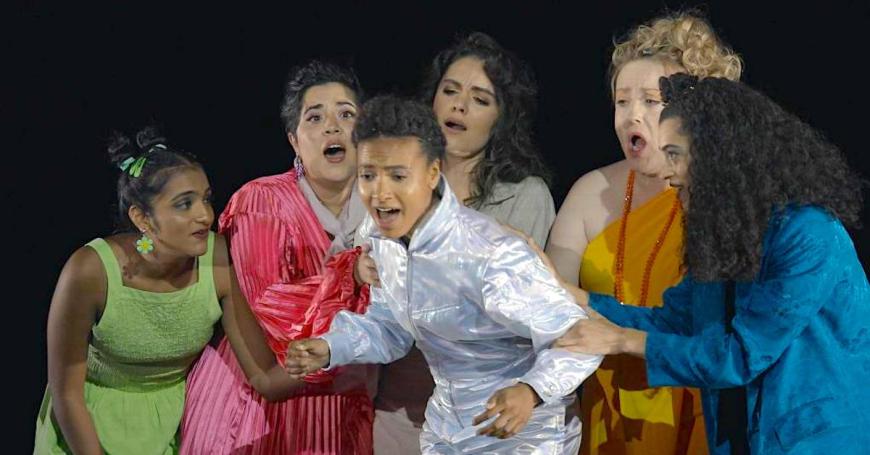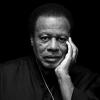
Opera, by its very nature, is artifice. But ... (Iphigenia) might very well be the apotheosis of artifice. Indeed, a collaboration between 11-time Grammy-Award-winning composer/saxophonist Wayne Shorter and four-time Grammy award-winning bassist, composer and vocalist esperanza spalding, the opera is a radical re-imagining of Euripides’s classical play Iphigenia at Aulis, which was first mounted in 405 B.C. But in this staging, the titular character is multiplied six-fold, creating a fractured identity that results in different manifestations of the myth.
With set designs by Los Angeles starchitect Frank Gehry and directed by Obie-Award winner Lileana Blain-Cruz, the production, which premiered in November in Boston as part of a four-month national tour, lands at The Broad Stage Feb. 18 and 19. Featuring a spalding-led cast of 15 and a 28-member chamber orchestra conducted by Clark Rundell, the work also includes jazz stars Brian Blade, John Patitucci, and Danilo Pérez from the Wayne Shorter Quartet.
The two-hour intermissionless opera, hailed by Michael J. West in JazzTimes as “riveting, fascinating, and rich with possible meanings,” also counts contributions by Pulitzer Prize-winning composer Caroline Shaw, while spalding’s libretto features additional text provided by, among others, U.S. Poet Laureate Joy Harjo.
Blain-Cruz, who came to the project about two years ago, extolled the work’s uniqueness. “The music, in and of itself, is already amazingly dense and exciting and thrilling. What excited me about working with Wayne and esperanza [is that] they are so charged in their life as artists and in their beings as artists, that that manifests inside of the work. They are not easily definable and the work isn’t either. It defies expectations.”
Shorter’s symphonic improvisational element is also key to the opera, while its numerous unpredictable moments include an unidentified character bounding across the stage carrying an inflatable sex doll. “That was my doing,” explained Blain-Cruz, letting out a robust laugh, “but it was also part of esperanza’s libretto. There’s a playfulness and campiness inside of that and playfulness is part of the improvisational aspect. I felt I learned about improv at this moment. They’re hearing each other making melodies, and that requires a deep level of listening.
“I know intellectually what [improvisation takes] but the focus to be so present with people is deeply moving and profound for me,” she continued. “It’s hard. It’s labor. I didn’t recognize the deep humanity in that, but in some ways, it pushed a performance style, it pushed at expectations. Everybody is on the ride together and [it] requires everybody staying really alive and present to each other and to listen to each other.”
Then there’s the notion that spalding chose not to write a predefined ending. Deciding, instead, to dispense with a domineering storyteller and allow the ending to be co-created by the performers — in effect, bringing the story through their bodies in real time — is a wild concept for any work, much less an opera.
“Esperanza kept being like, “Endings, I don’t know, I don’t know,” and I really wanted to honor that,” noted Blain-Cruz, whose upcoming projects include directing Missy Mazzoli’s new opera, The Listeners, that premieres in Norway this fall. “There is a conclusion in saying there is no defined ending,” the director added, “but it also allows for discovering what is inside the room and who are the people occupying it. On top of that, there’s Wayne saying, “I got some more music for you.” It’s both terrifying and thrilling.”
Gehry, whose mobile set design is rendered in earth tones and consists of, what The Washington Post critic Michael Andor Brodeur describes as, “a sky full of withheld wind,” joined the production because of his friendship with both Shorter and spalding. And while the trio worked out of Gehry’s Santa Monica home for some duration of the project, Blain-Cruz said she was not involved in those meetings.
“I didn’t get to hang out at his house, but we became close as we developed the world together. We started the design process before COVID and [since] this is jazz, this is Wayne Shorter, Gehry went along for the ride. These guys,” she pointed out, “are 88 [Shorter] and 93 [Gehry], so, what the fuck! If there’s any sense of inspiration, this is it and you can keep going. It’s good. It’s all good.”




